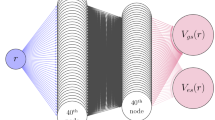Abstract
The origins and operation of artificial neural networks are briefly described and their early application to data modelling in drug design is reviewed. Four problems in the use of neural networks in data modelling are discussed, namely overfitting, chance effects, overtraining and interpretation, and examples are given of the means by which the first three of these may be avoided. The use of neural networks as a variable selection tool is shown and the advantage of networks as a nonlinear data modelling device is discussed. The display of multivariate data in two dimensions employing a neural network is illustrated using experimental and theoretical data for a set of charge transfer complexes.
Similar content being viewed by others
References
Eberhart, R.C. and Dobbins, R.W., Neural Network PC Tools, Academic Press, San Diego, CA, U.S.A., 1990, p. 1.
McCulloch, W.C. and Pitts, W., Bull. Math. Biophys., 5 (1943) 115.
Minsky, M. and Papert, S., Perceptrons, MIT Press, Cambridge, MA, U.S.A., 1969.
Livingstone, D.J., Data Analysis for Chemists: Applications to QSAR and Chemical Product Design, Oxford University Press, Oxford, U.K., 1995, p. 183.
Manallack, D.T. and Livingstone, D.J., In Van de Waterbeemd, H. (Ed.) Advanced Computer-Assisted Techniques in Drug Design, VCH, Weinheim, Germany, 1994, pp. 293–318.
Livingstone, D.J. and Salt, D.W., In Dean, P.M. (Ed.) Molecular Similarity in Drug Design, Blackie Academic & Professional, Glasgow, U.K., 1995, pp. 187–214.
Aoyama, T., Suzuki, Y. and Ichikawa, H., J. Med. Chem., 33 (1990) 905.
Aoyama, T., Suzuki, Y. and Ichikawa, H., J. Med. Chem., 33 (1990) 2583.
Andrea, T.A. and Kalayeh, H., J. Med. Chem., 34 (1991) 2824.
Salt, D.W., Yildiz, N., Livingstone, D.J. and Tinsley, C.J., Pestic. Sci., 36 (1992) 161.
Topliss, J.G. and Edwards, R.P., J. Med. Chem., 22 (1979) 1238.
Manallack, D.T. and Livingstone, D.J., Med. Chem. Res., 2 (1992) 181.
Livingstone, D.J. and Manallack, D.T., J. Med. Chem., 36 (1993) 1295.
Manallack, D.T., Ellis, D.D. and Livingstone, D.J., J. Med. Chem., 37 (1994) 3758.
Campbell, J.L.E. and Johnson, K.E., Can. J. Chem., 71 (1993) 1800.
Lewis, D.F.V., J. Comput. Chem., 10 (1989) 145.
Smolensky, P., Artif. Intel. Rev., 1 (1987) 95.
Goonatilake, S. and Khebbal, S. (Eds.) Intelligent Hybrid Systems, Wiley, Chichester, U.K., 1995.
Tetko, I.V., Livingstone, D.J. and Luik, A.I., J. Chem. Inf. Comput. Sci., 35 (1995) 826.
Livingstone, D.J., Data Analysis for Chemists: Applications to QSAR and Chemical Product Design, Oxford University Press, Oxford, U.K., 1995, pp. 65–89.
Tetko, I.V., Villa, A.E.P. and Livingstone, D.J., J. Chem. Inf. Comput. Sci., 36 (1996) 794.
Tetko, I.V., Tanchuk, V.Yu., Chentsova, N.P., Antonenko, S.V., Poda, G.I., Kukhar, V.P. and Luik, A.I., J. Med. Chem., 37 (1994) 2520.
Livingstone, D.J., Evans, D.A. and Saunders, M.R., J. Chem. Soc. Perkin Trans. II, (1992) 1545.
Wikel, J.H. and Dow, E.R., Bioorg. Med. Chem. Lett., 3 (1993) 645.
Livingstone, D.J., Methods Enzymol., 203 (1991) 613.
Hudson, B., Livingstone, D.J. and Rahr, E., J. Comput.-Aided Mol. Design, 3 (1988) 55.
Livingstone, D.J., Hesketh, G. and Clayworth, D., J. Mol. Graph., 9 (1991) 31.
Livingstone, D.J., In Devillers, J. (Ed.) Neural Networks in QSAR and Drug Design, Academic Press, London, U.K., 1996, pp. 157–176.
Livingstone, D.J., In Sanz, F., Giraldo, J. and Manaut, F. (Eds.) QSAR and Molecular Modelling: Concepts, Computational Tools and Biological Applications, J.R. Prous, Barcelona, Spain, 1995, pp. 18–26.
Author information
Authors and Affiliations
Rights and permissions
About this article
Cite this article
Livingstone, D., Manallack, D. & Tetko, I. Data modelling with neural networks: Advantages and limitations. J Comput Aided Mol Des 11, 135–142 (1997). https://doi.org/10.1023/A:1008074223811
Issue Date:
DOI: https://doi.org/10.1023/A:1008074223811




